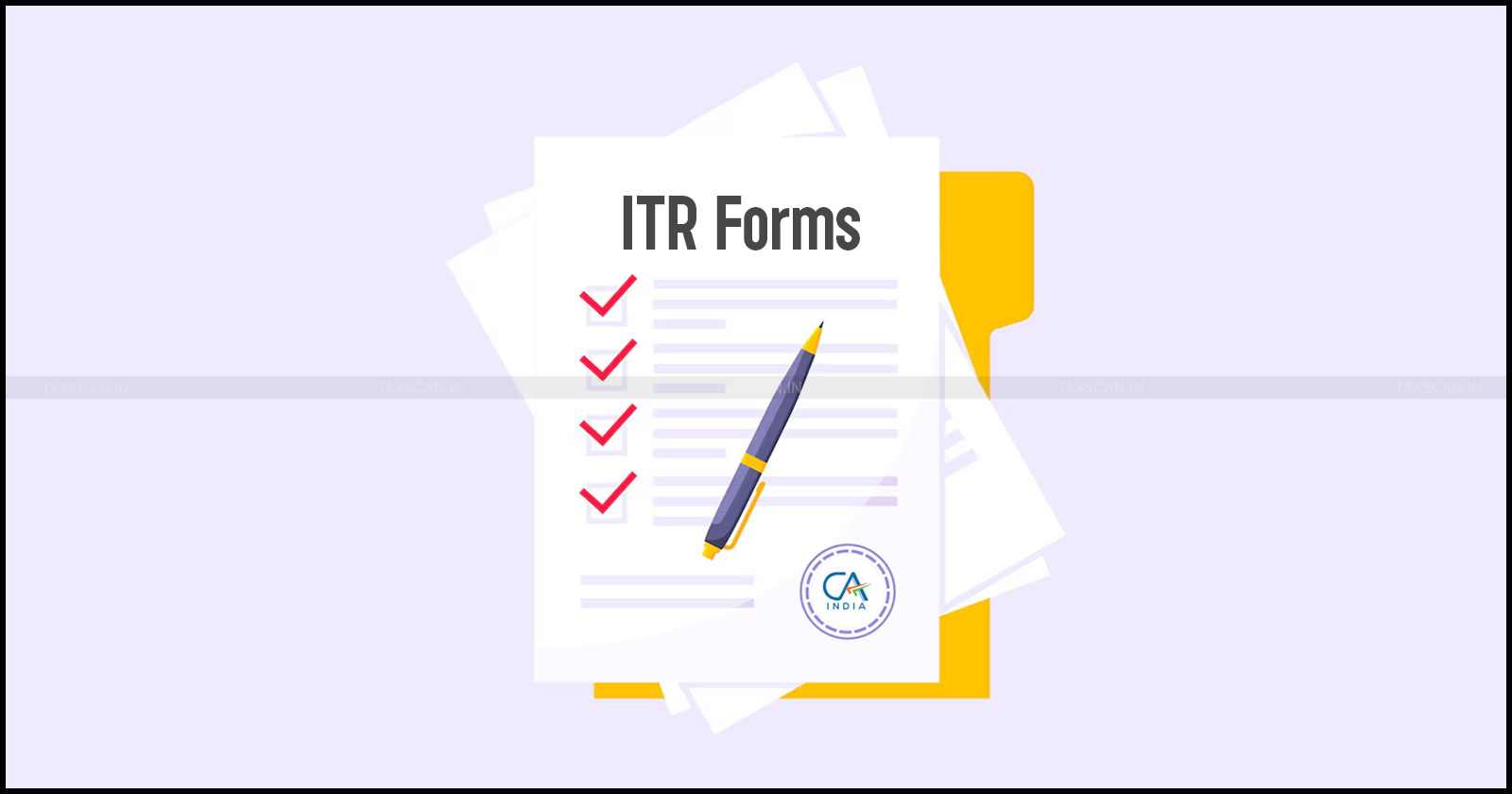Confused About Which ITR Form to File for AY 2025–26? Here’s Your Complete Guide
A comprehensive guide to filing Income Tax Returns for AY 2025�26, based on provisions under the Finance Act 2024 and CBDT's latest updates.

Confused – ITR Form to File – taxscan
Confused – ITR Form to File – taxscan
Filing your Income Tax Return (ITR) for the Assessment Year (AY) 2025–26, corresponding to the Financial Year (FY) 2024–25, requires careful selection of the appropriate ITR form based on income type, total income, residency status, and specific eligibility criteria. In light of the updates introduced by the Finance Act 2024 and notifications from the Central Board of Direct Taxes (CBDT), this guide aims to help resident individuals and Hindu Undivided Families (HUFs) navigate the filing process.
Overview of ITR Forms
For AY 2025–26, the Income Tax Department has notified seven ITR forms. However, individuals primarily use ITR-1 (Sahaj), ITR-2, ITR-3, and ITR-4 (Sugam). Each form caters to different taxpayer categories, and the selection depends on income type, amount, and other specific conditions.
Read More: Forgot Your Income Tax Login Password? Here’s How to Reset It Easily
ITR-1 (Sahaj): Simplified for Small Taxpayers
Eligibility:
- Resident individuals (excluding “not ordinarily resident”).
- Total income up to Rs. 50 lakh.
- Income from:
- Salaries and pensions.
- One house property (excluding cases with carried-forward loss).
Other sources (interest, etc., excluding lottery and race horses). - Long-term capital gains under Section 112A up to Rs. 1.25 lakh.
- Agricultural income up to Rs. 5,000.
Key Update for AY 2025–26:
- Inclusion of long-term capital gains up to Rs. 1.25 lakh under Section 112A (e.g., gains from listed equity shares and equity mutual funds). Previously, such gains required ITR-2.
Read More: ITAT Upholds Rs.1.5L Penalty on Jewellery Firm for Tax Audit Non-Compliance [Read Order]
Ineligibility:
- Income exceeds Rs. 50 lakh.
- Business or professional income.
- More than one house property.
- Agricultural income above Rs. 5,000.
- Company directors or holders of unlisted equity shares.
- TDS under Section 194N (excess cash withdrawals).
- Deferred tax on ESOPs.
- Ownership or authority over foreign assets/accounts.
Best For: Salaried individuals with straightforward financials and no complex transactions.
ITR-2: For Individuals and HUFs with Capital Gains or Foreign Income
Eligibility:
- Income from salary, pension, multiple house properties, capital gains, foreign income/assets, and agricultural income above Rs. 5,000.
- Total income can exceed Rs. 50 lakh.
- Applicable to non-residents and not ordinarily resident individuals.
Key Updates for AY 2025–26:
- Capital gains split reporting for transactions before/after July 23, 2024:
- Pre-July 23: 20% with indexation.
- Post-July 23: 12.5% without indexation.
- Capital loss on share buybacks allowed (effective October 1, 2024).
- Asset/liability disclosure threshold raised to Rs. 1 crore (previously Rs. 50 lakh).
- The TDS section code column has been added in Schedule-TDS.
- Detailed deductions reporting, e.g., Sections 80C, 80DD, 80U, 10(13A), including disability certificates where applicable.
Ineligibility: Income from business or profession (requires ITR-3).
Best For: Investors, HUFs, expatriates, and individuals with foreign assets or complex income sources (excluding business income).
Read More: Pen Drive cannot be Incriminating Material: Delhi HC sets aside Notice issued u/s 153C of Income Tax Act [Read Order]
ITR-3: For Business or Professional Income (Non-Presumptive)
Eligibility:
- Individuals/HUFs with business or professional income not covered under presumptive taxation.
- Income from:
- Salaries.
- House property.
- Other sources.
- Capital gains.
- Unlisted equity shares.
- Share of income from partnership firms (not the firm’s return).
Key Updates for AY 2025–26:
- Same capital gains bifurcation as ITR-2 for transactions before/after July 23, 2024.
- Enhanced reporting for business financials: Profit & Loss account, Balance Sheet required.
Ineligibility: Those eligible for presumptive taxation under Sections 44AD, 44AE, or 44ADA (should use ITR-4).
Best For: Professionals (doctors, lawyers) or proprietors who maintain detailed books and file under normal computation provisions.
ITR-4 (Sugam): For Presumptive Taxation
Eligibility:
- Residents, HUFs, and firms (excluding LLPs).
- Total income up to Rs. 50 lakh.
- Income from:
- Presumptive business/profession under Sections 44AD, 44AE, or 44ADA.
- One house property.
- Other sources (excluding lottery/race horses).
- Long-term capital gains under Section 112A up to Rs. 1.25 lakh.
Key Update for AY 2025–26:
- Inclusion of LTCG up to Rs. 1.25 lakh under Section 112A, aligning with ITR-1 for small investors and business owners.
Ineligibility:
- Income > Rs. 50 lakh.
- Multiple house properties.
- Foreign assets or income.
- Directorship or investment in unlisted shares.
- Non-residents or NOR individuals.
- Agricultural income > Rs. 5,000.
Best For: Small businesses or professionals opting for presumptive taxation, with minimal compliance requirements.
Read More: 11 Years of PM Modi Sarkar: A Look at Key Tax Reforms Fueling India’s Growth
Other ITR Forms
ITR-1 to ITR-4 are most commonly used by individual taxpayers and HUFs but the remaining ITR forms are applicable to companies, firms, trusts, and other specified entities. Here is a brief overview of the other ITR forms notified for AY 2025–26:
ITR-5: For Firms, LLPs, AOPs, BOIs, and Others (Not Individuals or HUFs)
Applicable to:
- Firms
- Limited Liability Partnerships (LLPs)
- Association of Persons (AOPs)
- Body of Individuals (BOIs)
- Artificial Juridical Persons
- Estate of deceased or insolvent persons
Not applicable to:
- Individuals
- HUFs
- Companies required to file ITR-6
Key Points:
- Includes detailed disclosures for business income, profit-sharing ratios, and partners' capital.
- Requires balance sheet and P&L details if the books of accounts are maintained.
- Applicable even if income is under presumptive taxation, capital gains, or house property.
Read More: ITAT Overturns CIT(A) Order: Notices Wrongly Sent via Email Despite Assessee’s Explicit Opt-Out [Read Order]
ITR-6: For Companies Other Than Those Claiming Exemption Under Section 11
Applicable to: Companies other than those whose income is exempt under Section 11 (i.e., income from property held for charitable or religious purposes)
Key Points:
- Mandatory electronic filing with a digital signature.
- Requires detailed financial reporting, including profit and loss account, balance sheet, audit reports, and disclosures for MAT (Minimum Alternate Tax) under Section 115JB.
ITR-7: For Persons Including Trusts, Political Parties, Charitable Institutions Claiming Exemption Under Sections 11, 12, 13A, 10(23C), etc.
Applicable to:
- Charitable or religious trusts
- Political parties
- Scientific research institutions
- News agencies
- Universities, colleges, or institutions claiming exemption under specific sections of the Income Tax Act
Complete Referencer of GSTR-1, GSTR-1A, GSTR-3B, GSTR-9 & GSTR-9C Click Here
Key Points:
- Must report registration details under applicable sections.
- Detailed disclosures about donations received, application of income, and compliance with conditions under exemption provisions.
Read More: ITAT Sets Aside Ex-Parte CIT(A) Order Due to Invalid Notice Service [Read Order]
Key Changes for AY 2025–26
1. Default Tax Regime:
- New tax regime is now the default for individuals, HUFs, AOPs (excluding co-ops), BOIs, and Artificial Juridical Persons.
- Taxpayers can opt out by submitting Form 10-IEA (for business income cases) within the due date under Section 139(1).
2. Capital Gains Tax Treatment:
- New bifurcation for LTCG before/after July 23, 2024:
- Before: 20% with indexation.
- After: 12.5% without indexation.
3. Asset Reporting Threshold Increased: From Rs. 50 lakh to Rs. 1 crore in ITR-2, easing compliance for smaller taxpayers.
4. Enhanced Disclosures: More granular reporting for deductions, TDS codes, and exemptions.
How to Choose the Right ITR Form: Step-by-Step Guide
To determine the appropriate ITR form, follow these steps:
- Determine Residency Status: Confirm if you are a resident, non-resident, or not ordinarily resident. ITR-1 and ITR-4 are only for residents.
- Check Total Income: Ensure your total income does not exceed Rs 50 lakh if considering ITR-1 or ITR-4. For higher income, use ITR-2 or ITR-3.
- Identify Income Sources:
- If only salary, one house property, and other sources (with exclusions), consider ITR-1.
- If you have business or professional income:
- Use ITR-4 if under presumptive taxation (Sections 44AD, 44AE, 44ADA).
- Use ITR-3 if computed under normal provisions.
- If you have capital gains, foreign assets, or income, use ITR-2 (if no business income) or ITR-3 (if business income).
- Check Exclusions: Ensure you do not fall under ineligibility criteria, such as being a company director, having unlisted equity investments, or foreign assets, which may require ITR-2 or ITR-3.
- Consider Special Cases: For long-term capital gains up to Rs 1.25 lakh under Section 112A, you can use ITR-1 or ITR-4 if eligible. For gains exceeding this or other types, use ITR-2.
Read More: Likelihood of Extension for ITR Filing this Year Unlikely! Know Why
3000 Illustrations, Case Studies & Examples for Ind-AS & IFRS Click Here
Practical Example
- Case 1: You are a salaried employee with Rs 40 lakh income from salary, Rs 2 lakh from one house property, and Rs 50,000 interest income, with no foreign assets. You can file ITR-1.
- Case 2: You have Rs 60 lakh income, including Rs 20 lakh capital gains from shares and Rs 40 lakh salary, with no business income. You must file ITR-2 due to income exceeding Rs 50 lakh and capital gains.
- Case 3: You run a small business with presumptive income of Rs 30 lakh under Section 44AD, and Rs 10 lakh salary. You can file ITR-4, provided no foreign assets.
Support our journalism by subscribing to Taxscan premium. Follow us on Telegram for quick updates


